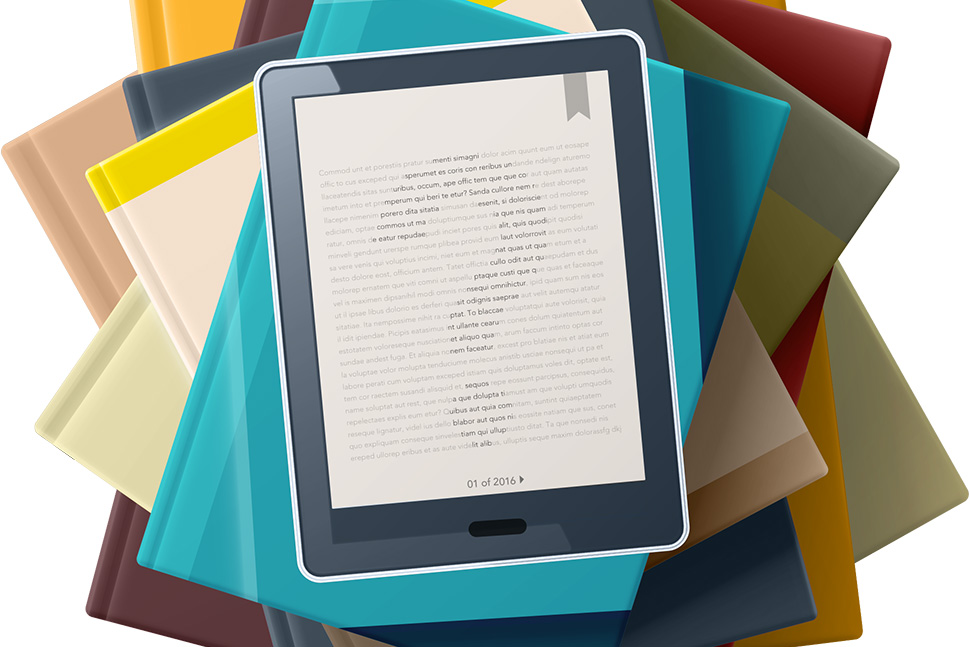
In 2008, a little more than $1 out of every $100 in total publishing trade revenue went to ebook sales. Just four short years later, it had jumped to $23 of every $100. The 2014 data—from the Association of American Publishers (AAP)—also shows that the ebook market share continues to hover around a quarter of total trade sales.
What accounts for the sudden and rapid growth? One answer: the introduction of Amazon’s Kindle in 2007. In response to the disruption that ensued—specifically for library ebook sales and lending—ALA established the a working group on libraries and digital issues (now known as the Digital Content Working Group, or DCWG) to help navigate the Association and the library community through the tumult, such as when some of the largest publishers wouldn’t even sell ebooks to libraries.
Now that the initial crisis has subsided and the market share has leveled off, it’s a good time to assess what’s in store for ebooks—and especially for libraries and other intermediaries, such as bookstores—in 2016 and beyond.
We interviewed four prominent figures in the ebook sector—three from the industry and one from libraries—to get their varying perspectives:
- Andrew Albanese, senior writer and features editor for Publishers Weekly. He has held editorial positions at Oxford University Press, Penguin Books USA, and Library Journal.
- James LaRue, former director of Douglas County (Colo.) Libraries who led path-breaking efforts on library ebook lending until 2014. He writes, speaks, and consults on leadership, organizational development, and the future of libraries.
- Mike Shatzkin, founder and CEO of The Idea Logical Company and serves as conference council chair of the Digital Book World conference. He has been involved in the publishing business for nearly 50 years.
- Maja Thomas, consultant and longtime publishing executive and entrepreneur. She is a former senior vice president at Hachette Book Group.

AMERICAN LIBRARIES: After several years of rapid growth, the market share for ebooks has plateaued. What accounts for this shift, and do you expect growth to resume in the next year or two?
LARUE: There are several factors for the plateau, I suspect. First, even the most assiduous reader cannot keep up with the flood of new content. After every big change, there’s a natural slide back to the comforts of what worked before. Ebooks aren’t going away, and they represent such a potential gain for authors—in speed to market and share of revenue—that ebooks will, I predict, surge again inevitably. For libraries, our digital collections have grown much more slowly than the marketplace. We’re seeing this advanced market segment moving to nonlibrary and nontraditional sources. Wooing them back to the library won’t be easy.
THOMAS: The rapid expansion in ebooks was unusual, even compared with other shifts such as in digital music, which wasn’t as sudden, and audiobooks took 20 years. We saw a steep adoption curve among core readers. Publishers hoped that this growth would extend beyond core readers, but that didn’t happen. This shift to devices caused an initial surge in purchases, but once readers had a base catalog of titles, new purchases resumed at the normal rate for new purchases.
Market share in the 20% range is a substantial business and not a disappointment. In fact, the market stability we’ve seen is reassuring to publishers as the hardcover and paperback businesses were not destroyed as feared. But it is clear that ebooks are here to stay. I expect measured growth in percentage terms over the next years as digital natives become an increasing proportion of consumers.
SHATZKIN: The plateauing effect derives from three factors present during the initial surge of ebook sales and ebook readers: People would purchase titles that they love and want on their device. Then there are reference works. And finally there are aspirational acquisitions of what people would like to read. These were largely one-time purchases; once filled, people’s purchasing level reverted back to their reading pace. I expect sales will rise again but not at the dramatic pace of three or four years ago.
ALBANESE: With so much consumption now happening on the same screen, we are in a moment in time when we are figuring out what the true value proposition is for ebooks—not only in terms of buying access to a locked-down file that lives in the ether versus buying a print book, but between paying $14.99 for a single ebook title versus $8.99 a month for unlimited Netflix viewing.
But I also believe that the major publishers are seeing more competition from indie ebooks and self-published ebooks. Amazon has a million titles accessible, many of which are free or very inexpensive. I think the internet has leveled the playing field a bit for self-published and small indie publishers, enabling more players to reach more readers, and these sales are not measured—at least not reliably—in industry statistics.
Anecdotally, I think people are reading digitally more than ever before, despite the plateau in the reported ebook statistics. In the long run, most people expect the plateau to end and growth to resume, quite possibly fueled by reading on mobile phones.
Technology has the potential to enable significant innovation in ebook products, yet we have seen mostly incremental improvements. Is this trend likely to continue?
ALBANESE: For the near future, yes, incremental improvement at best—and this, to me, is the only plateau we should be paying attention to. Everything on my digital device gets cooler and cooler, it seems, except ebooks, which still, to this point, are mostly re-creations of print books on digital screens. And despite their lack of innovation, ebooks are getting more expensive.
There is a simple explanation as to why: The publishing business is still largely based on print, and publishers are trying to manage their legacy print businesses and their emerging digital businesses to some sort of equilibrium on a timeline they can handle. Keep in mind that publishers control the book reader technology—that is, print. But for ebooks, the reading experience is largely mediated by third-party platforms. Innovation will happen, but it will take a bit of time, though more publishers are willing to experiment.
LARUE: The short answer is that big publishers are even slower to embrace significant change than libraries. They persist in seeing ebooks as the digitized file only, a product they think they understand. If they can take an existing product and find a new and higher margin, that’s cheap and easy. Most publishers haven’t really grasped the idea of added value, the capacity of the e-publication to include audio and video clips, to feature author interviews or special edition illustrations. Why? Because those features represent new costs, but they have not yet demonstrated new profit. As always, it will take some risk-taking companies—probably not the Big Five [Hachette Book Group, HarperCollins, Macmillan, Penguin Random House, and Simon & Schuster]—to show how it’s done. Meanwhile, children’s publishers still seem to be the most innovative. In part, this is attributable to an audience that is more technology curious.
SHATZKIN: Yes, I see this trend continuing. The idea that people will cotton to a completely new product that incorporates video, audio, interactivity, and other novel capabilities has been an illusion chased by various people for the past 25 years. Maybe someday something will be created, but if so, I suspect it will not emerge from book publishing but rather from the movie, game, or other industry sector. Book reading is a rather well-established practice. Digital technology has made that practice easier, cheaper, and more portable. But going from incremental improvements to the expectation that people want something completely different is a romantic notion.
THOMAS: Publishers were super excited about the opportunity to innovate in digital books and experiment with a bunch of things, such as interactivity. However, consumers did not care; they yawned at the bells and whistles we created. Of course, adding such features generates more costs, but consumers were not willing to pay for them. So we concluded that there wasn’t enough of a market there to justify incorporating major technological innovations in ebooks. One important exception are ebooks intended for children. In this market segment, technological enhancements are more important because many competitors for children’s attention have those features. Publishers in this market segment are being aggressive in the use of technological innovation, such as personal customization.
What are your thoughts about the evolution of bookstores, distributors, libraries, and other intermediaries? Any significant changes looming?
ALBANESE: It’s challenging to be an intermediary at a time when technology is enabling unprecedented direct-to-consumer interaction. So, if you are going to be an intermediary, you better add value. And, you better continue to keep an eye on the future. I’d like to see more openness. Many intermediaries have launched their businesses—Amazon, for example—on closed, proprietary platforms that lock consumers in, which is far from ideal. In fact, I think it is dangerous.
THOMAS: Many independent bookstores did close, but we are now seeing a resurgence. Nothing more surprising than Amazon opening a brick-and-mortar store, which is novel for a digital-first company. The Amazon store uses dynamic pricing, matching store prices to Amazon online pricing. So Amazon may be an innovator in this other direction too: digital to physical. With this investment, it is another signal that people think print will be around in a significant way for some time to come. The in-person, physical store experience does have value that cannot be duplicated online. And the same thing is true for libraries: Parents will continue to want to take their kids to story hour, and that cannot be replicated on the web.
LARUE: The problem of the 21st century is being noticed. Bookstores and libraries remain one of the few social places where people can browse for new content. The resurgence of independent bookstores—although by no means uniform across the United States—is a sign that people still want to read, and they’re curious about what’s hot. But we—bookstores, libraries, and distributors—still haven’t solved how to display e-only titles. I am still surprised we haven’t seen any joint marketing efforts by publishers and distributors. Right now, the two best bets in the market are Odilo and Total Boox: alternatives that are at least experimenting with discounts and the elimination of early limits to borrowing.
SHATZKIN: Bookstores are challenged by two major transitions: First, from reading on paper to reading on screens, and second, from buying in stores to buying online. These two migrations threaten bookstores—and publishers too, since part of a publisher’s value is getting an author’s work into bookstores and other intermediaries.
Bookstores remain important to publishers and distributors, but as people buy more ebooks, those transactions won’t be happening in bookstores. Over time, it is going to be harder for bookstores to survive, but they won’t disappear like video or record stores.
What should the library community emphasize in the next couple of years? What’s your opinion on nonprofit efforts to provide ebook services in the library market?
THOMAS: Libraries are key to the reading ecosystem. Their importance cannot be overstated. Libraries provide consumers with no-risk ways to try new media. The large majority of people are not early adopters, so having a place where anyone can walk in and try out and learn about new technologies—accessing ebooks on smartphones, preloaded iPads or Kindles, and the like—is enormously useful. What’s more, librarians also learn about the newest services and technologies and provide information and objective feedback about them.
Regarding ebook services, the proliferation of titles—through inexpensive (for example, $1.99 titles) and self-published ebooks creates opportunity for new players (and potentially for libraries). At face value, this phenomenon poisons the well: The reader is now exposed to a much more uneven experience than when publishers previously served as gatekeepers to ensure minimum quality levels. While barriers for authors are lower, readers face a higher chance of a truly poor experience. Thus, there is space for new players of curatorial or recommendation services beyond the bestseller list. Which of these many works are solid works worth reading and how can the reader discover and obtain them?
ALBANESE: Libraries are in a very precarious spot right now. It would be a mistake to accept the current restrictions on library ebook lending as the way things have to be. For example, I don’t see any reason why a library should not be able to buy ebooks like they buy print books, and at the same prices. To me, there is virtually no difference between a print book and a copy of a digital book that is locked down and can be read by only one user at a time. And I have yet to hear a compelling argument otherwise.
Amazon and Netflix are redefining consumer expectations for accessing digital content, and libraries cannot allow themselves to settle on a plateau of mediocrity. I understand the fear and caution that came with the early days of digital. But publishers and libraries are invested in the same things. Together, they should form a bulwark against companies whose innovation in the short term comes with a price in the long term.
And a library’s own nonprofit ebook services are a necessary component for that future. One key challenge is to move from being content collectors and purchasers to providing tools and platforms to foster creativity. Collecting, preserving, and making available a community’s cultural output should remain a vital role for libraries. We can figure out a way to offer access to the new bestseller, but that may be the least of the challenges facing libraries in the digital future.
SHATZKIN: When Andrew Carnegie began to put money into libraries, it was the only place for most people to have access to reading. The idea that libraries are a place to collect books is increasingly obviated by the digital reality, and I’d expect to see fewer books in libraries in the long run. In particular, the subscription ebook business threatens libraries, but it isn’t clear yet how commercially viable it will be. Many libraries understand that the subscriber ebook business competes with them.
On the other hand, librarianship is needed more than ever as there is more and more to read. There is real value in having professionals help navigate all that material, much of it unknown to most people. Now that has real value. As a result, libraries in the digital world will be different than in the physical world, but I don’t know how that gets sorted out. I see the library having decreasing value in the future but the librarian having increasing value.
LARUE: I continue to believe that libraries have to dive into and dedicate real money to the new independent publisher content and self-published content. But I don’t think it can be done without a network of larger library consortia, librarian-managed repositories. I like very much the Open Books initiative, the Digital Public Library of America, the Library Simplified app, and the experiments of Unglue.it. The good news: It does seem that the profession is still tinkering at the edges and trying to stay in the game.
However, the library community should not invest in incremental ideas. Why invest in a statewide integrated library system? It doesn’t solve any new problems. Address the actual critical issues. Now that we are getting beyond the recession of the past years and with a large cadre of senior librarians on the cusp of retiring, the library community has an opportunity for true innovation. It is time to be bold. Let’s try stuff.


